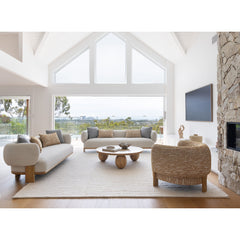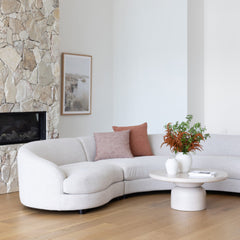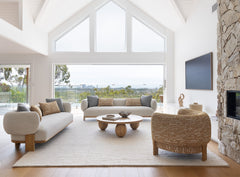Smart Styling Hacks for Small Living Rooms
Styling a small living room can feel like a puzzle. You want it to look good, feel comfortable, and work for everyday living, without feeling crowded. The good news? With a few smart tricks and the right furniture choices, even the most compact space can feel open, bright, and beautifully styled.
From clever layouts and colour choices to space-saving furniture and vertical styling, this article offers a detailed roadmap to help you make the most of your space. Whether you're working with a narrow room, a small apartment lounge, or a tiny open-plan area, you’ll find practical ideas here to create a living room that truly works for you.

Start with a Plan and Prioritise the Essentials
Measure Your Living Room
Before you buy a thing, grab a tape measure. Measure the length and width of your room, taking note of any awkward corners, windows, or doors. Sketch a quick floor plan or use a free online room planner. This helps you avoid buying furniture that doesn't fit and makes layout planning easier.
Knowing the exact dimensions also helps you determine what kind of furniture will suit your space without compromising movement. For example, a 2-seater lounge might be perfect for a 3m x 3m room, whereas a full-sized sectional would overwhelm it. A smart layout starts with accurate measurements.
Identify How You Use the Room
Do you mostly relax and watch TV? Host friends occasionally? Need a quiet nook for reading or remote work? Understanding how you use your space helps you decide what’s essential. Prioritise those pieces first a comfy sofa, a designer coffee table, maybe a small side table or shelf.
This step will also guide your zoning decisions. If your living room doubles as a dining area or workspace, that should influence where you place furniture and how much open space you need.
Clear Out What You Don’t Need
Decluttering is key. A small room can quickly feel chaotic when it’s full of things you rarely use. Keep the essentials, store or donate the rest. Think quality over quantity.
If you haven’t used it in six months, ask yourself whether it still deserves space. Try removing everything from the room and reintroducing only what you truly need or love. This creates a clean slate for styling and opens up space for multifunctional solutions.
Choose Furniture That Works Smarter, Not Harder
Pick Compact Sofas and Chairs
Large sectionals might be tempting, but they often overpower small rooms. Instead, go for a compact 2-seater lounge or armless chairs with slim frames. Raised legs help make the room feel airier by revealing more floor space.
You can also consider a loveseat or modular sofa that fits your floor plan precisely. Pieces with sleek profiles not only take up less room but also give your living area a more refined look.
Use Multi-Functional Pieces
Look for pieces that serve more than one purpose. Ottomans with hidden storage, nesting coffee tables, or a stylish sofa bed can save loads of space. These options let you keep things tidy and versatile.
Another idea is to use a slim bench under a window with built-in storage, or a lift-top coffee table that doubles as a dining surface for small apartments. The goal is to combine style and utility.
Choose Raised and Light-Profile Designs
Furniture with exposed legs and slim silhouettes helps open up a room visually. Avoid bulky armrests and oversized designs. Sleek, low-profile pieces make your lounge feel light and uncluttered.
A lighter base creates the illusion of more floor area. Transparent or glass-top coffee tables can also be effective in maintaining an open feel, as they allow light to pass through and avoid visual heaviness.
Maximise Vertical Space for Storage and Style
Install Floating Shelves or Wall Units
Instead of bulky floor storage, go up! Floating shelves are perfect for books, plants, and decorative objects without taking up precious floor space. They help you stay organised and add personality to your room.
Vertical storage makes use of blank walls and frees up your footprint. A single column of open shelves can store everything from photo frames to speakers without making the room feel busy.
Wall-Mount Your TV and Art
Free up space by mounting your TV instead of using a stand. Hanging your artwork or decorative mirrors higher on the wall also draws the eye upward, making the room feel taller.
Use this opportunity to style a gallery wall above your luxury sofa or place a large framed piece as a focal point. Keeping visual interest off the floor prevents the space from feeling boxed in.
Use Tall, Narrow Storage
Designer bookcases or ladder-style shelves make the most of unused vertical space. They’re ideal for storing and displaying without cluttering your floor. Just make sure to keep heavier items low for balance.

If you have alcoves or corners, consider custom-fitted storage that reaches the ceiling. These areas are often overlooked but can be transformed into useful and stylish spaces.
Let Light and Colour Open Up the Room
Stick to a Light Colour Palette
Lighter tones like white, cream, soft grey, or pale blue reflect more light and make your space feel open and airy. Use these shades on walls, furniture, and larger decor pieces.
Try to keep larger furniture pieces and rugs in similar tones to the wall colour to blend them into the room. This creates a seamless look and reduces visual clutter.
Keep Window Treatments Light
Avoid heavy, dark curtains that block natural light. Go for sheer curtains, light linen panels, or blinds that let sunlight filter in. Keep window areas clear where possible.
Mount curtain rods closer to the ceiling and extend them wider than the window frame. This technique makes the windows (and the room) appear larger.
Use Mirrors to Reflect Light
Mirrors are a small secret weapon. Placing a mirror opposite a window or light source can double the natural light and visually expand the room. Bonus: they make a great design statement.
You can also place a mirror behind a lamp to bounce the glow and brighten darker corners. Decorative mirror panels or mirrored furniture can have the same effect.
Layer Your Lighting
Don’t rely on just one overhead light. Use a mix of floor lamps, table lamps, or wall lights to create a warm and inviting atmosphere. Soft, warm bulbs work best to make the space feel cozy.
Consider smart lighting or dimmable switches to change the mood depending on the time of day. Think of lighting as both functional and decorative.
Arrange for Flow, Not Just Fit
Leave Clear Walkways
Make sure there's enough space to move around comfortably. Leave about 60cm between furniture pieces so the room doesn’t feel cramped. Avoid placing large items where they block doorways or natural light.
Good layout = good energy. When a room feels easy to move through, it feels more inviting. Test your space by walking around to see if you can move freely.
Use Corners Effectively
Corners are valuable real estate in small rooms. Fit in a corner bookshelf, a corner & chaise lounge, or a tall plant. Just don’t overfill the space, keep it balanced.

Diagonal placement of small furniture, like a round table or accent chair, can break up boxy layouts and create a dynamic look.
Zone Shared Spaces
In an open-plan layout, define your living space with a rug or a narrow console table. These small touches help create a sense of structure without adding bulk.
Visual zoning makes small areas feel more organised. You can also use lighting (like a pendant above the coffee table) or colour (e.g., a darker accent wall) to divide areas.
Add Personality Without Adding Clutter
Choose 1–2 Focal Points
Pick one or two standout items to build your look around: a bold artwork, a colourful chair, or a sculptural lamp. Let those pieces shine, and keep other decor simple.
Trying to showcase too many pieces at once can feel overwhelming in a small room. Instead, rotate your decor seasonally to keep things fresh without cluttering the space.
Layer Textures for Warmth
Use a mix of cushions, throws, and rugs in different textures (like linen, velvet, and jute) to add depth and comfort. Stick to a limited colour palette to avoid visual clutter.
Group textiles in layers to create a cosy feel. For example, place a knitted throw over a velvet sofa and pair it with natural fibre cushions.
Use Plants and Storage Together
Add life to your space with a few indoor plants. Use stylish storage baskets or ottomans to hide everyday messes like remote controls or kids’ toys.
Try placing a trailing plant on a high shelf or using a plant stand to add height. Look for furniture that includes hidden storage to stay organised.
Final Thoughts
A Small Room Can Still Feel Big
Don’t let size limit your style. With a few intentional choices, your small living room can feel welcoming, open, and beautifully designed.
Don’t Be Afraid to Experiment
Try rearranging your layout or swapping out a bulky item for a sleeker one. Styling is personal and flexible – keep trying until it feels right.
Be patient. Often, the perfect layout or piece takes a few tries to find. Don’t rush the process—enjoy it.
Explore Smart Furniture Options
Looking for pieces that bring style, comfort, and functionality to your small space? Discover Bay Gallery’s luxury indoor furniture collection designed with small homes in mind.





